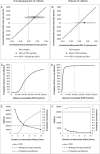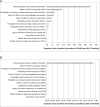The cost-effectiveness of a theory-based online health behaviour intervention for new university students: an economic evaluation
- PMID: 25262372
- PMCID: PMC4195974
- DOI: 10.1186/1471-2458-14-1011
The cost-effectiveness of a theory-based online health behaviour intervention for new university students: an economic evaluation
Abstract
Background: Too many young people engage in unhealthy behaviours such as eating unhealthily, being physically inactive, binge drinking and smoking. This study aimed to estimate the short-term and long-term cost-effectiveness of a theory-based online health behaviour intervention ("U@Uni") in comparison with control in young people starting university.
Methods: A costing analysis was conducted to estimate the full cost of U@Uni and the cost of U@Uni roll-out. The short-term cost-effectiveness of U@Uni was estimated using statistical analysis of 6-month cost and health-related quality of life data from the U@Uni randomised controlled trial. An economic modelling analysis combined evidence from the trial with published evidence of the effect of health behaviours on mortality risk and general population data on health behaviours, to estimate the lifetime cost-effectiveness of U@Uni in terms of incremental cost per QALY. Costs and effects were discounted at 1.5% per annum. A full probabilistic sensitivity analysis was conducted to account for uncertainty in model inputs and provide an estimate of the value of information for groups of important parameters.
Results: To implement U@Uni for the randomised controlled trial was estimated to cost £292 per participant, whereas roll-out to another university was estimated to cost £19.71, both giving a QALY gain of 0.0128 per participant. The short-term (6-month) analysis suggested that U@Uni would not be cost-effective at a willingness-to-pay threshold of £20,000 per QALY (incremental cost per QALY gained = £243,926). When a lifetime horizon was adopted the results suggest that the full implementation of U@Uni is unlikely to be cost-effective, whereas the roll-out of U@Uni to another university is extremely likely to be cost-effective. The value of information analysis suggests that the most important drivers of decision uncertainty are uncertainties in the effect of U@Uni on health behaviours.
Conclusions: The study provides the first estimate of the costs and cost-effectiveness of an online health behaviour intervention targeted at new university students. The results suggest that the roll-out, but not the full implementation, of U@Uni would be a cost-effective decision for the UK Department of Health, given a lifetime perspective and a willingness-to pay threshold of £20,000 per QALY.
Trial registration: Current Controlled Trials ISRCTN67684181.
Figures




References
-
- National Centre for Social Research . Health Survey for England 2008. 2008.
-
- Parliamentary Office of Science and Technology . Postnote number 283: Health Behaviour. London: Parliamentary Office of Science and Technology; 2007.
-
- Epton T, Norman P, Sheeran P, Harris PR, Webb TL, Ciravegna F, Brennan A, Meier P, Julious SA, Naughton D, Petroczi A, Dadzie A, Kruger J. A theory-based online health behavior intervention for new university students: study protocol. BMC Public Health. 2013;13:107. doi: 10.1186/1471-2458-13-107. - DOI - PMC - PubMed
-
- Harris PR, Epton T. The impact of self-affirmation on health cognition, health behavior and other health-related responses: a narrative review. Soc Pers Psychol Comp. 2009;3:962–978. doi: 10.1111/j.1751-9004.2009.00233.x. - DOI
-
- Ajzen I. Attitudes, Personality and Behaviour. Milton Keynes: Open University Press; 1988.
Pre-publication history
-
- The pre-publication history for this paper can be accessed here:http://www.biomedcentral.com/1471-2458/14/1011/prepub
Publication types
MeSH terms
Associated data
Grants and funding
LinkOut - more resources
Full Text Sources
Other Literature Sources
Medical

